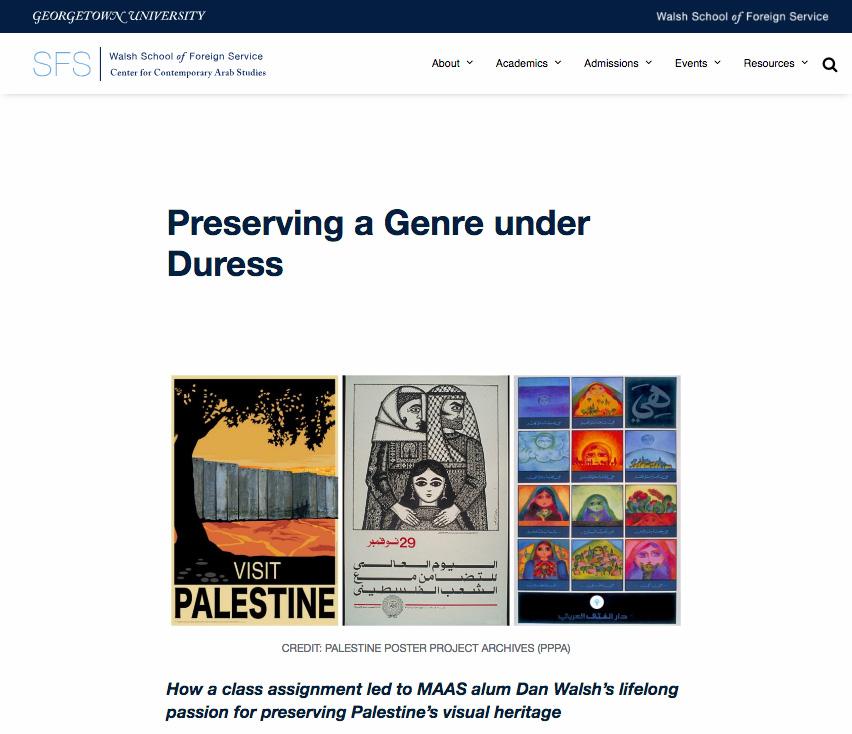The poster by Amer Shomali may be viewed here
The poster by Burhan Karkoutly may be viewed here
The poster by Helmi Eltouni may be viewed here
_________________________________________
Preserving A Genre Under Duress
How a class assignment led to MAAS alum Dan Walsh’s lifelong passion for preserving Palestine’s visual heritage
By Brittni Foster
When Dan Walsh (MAAS ’11) was serving as a Peace Corps volunteer in Marrakesh in the early 1970s, his language tutor encouraged him to practice his budding Arabic and Moroccan Darija skills by translating the posters that papered the buildings around town. Walsh, now the curator of the world’s largest collection of posters on Palestine, remembers how grateful he was for the break from verb conjugations but says he never could have imagined how that assignment would change the course of his career. He credits his hours spent walking the streets of Marrakech and Rabat reading posters—Arabic dictionary in hand—with not only improving his language skills, but also igniting what has become one of his life’s passions.
The poster that started it all was one portraying an armed guerilla fighter that Walsh spotted on an office building in Rabat. “It only had one word, but I couldn’t translate it,” recalls Walsh. “A man came out of the building and saw me trying to translate this word with my dictionary, so he came over and said, ‘The word is Palestine.’”
Walsh responded, “Oh, Palestine! You mean the terrorists?” This was not an uncommon narrative at the time, only a few years after the June 1967 war. Laughing, the man invited Walsh inside the building. Walsh soon learned that this man was the official representative of the Palestine Liberation Organization (PLO), and the building was the PLO headquarters in Morocco. Toward the end of their conversation, the officer led Walsh to a closet containing posters about Palestine from all over Europe and the Middle East. Walsh left with dozens of posters under his arm and an invitation to return anytime. “That’s how it all began,” says Walsh
Following his stint in the Peace Corps and his graduation from Ohio State University, Walsh began a 30-year career running his own design and distribution company, Liberation Graphics. During that time, he continued to build his Palestine poster collection, which now includes 12,000 posters known collectively as the Palestine Poster Project Archives. Though he was often invited to give presentations on the posters, Walsh says that he only understood the genre from the “perspective of an activist and artist.”
It was when Walsh became a student in Georgetown’s Master of Arts in Arab Studies program at the age of 55 that the Palestine Poster Project truly began to evolve, thanks to the refined understanding he gained of the Israel-Palestine conflict and support for his project from CCAS Professor of Anthropology Rochelle Davis. “The sort of intellectual architecture that visual anthropology requires meant that I had to study different sources and consider how Palestine posters compare to others published in Russia or Cuba or Europe,” says Walsh. “It turns out that almost everybody everywhere has something to say about Palestine.”
For Walsh, preserving the visual and artistic documentation of the Palestinian liberation movement is a key component of the project. “For the first time in history, we may be able to reconstitute an entire lost genre of art,” he says, referring to the destruction of protest posters by Israelis in the 1982 invasion of Lebanon, Israeli laws banning “political” posters, and other expressions of resistance, as well as the fundamental transiency of works-on-paper. Though the genre has been under existential threat for a long time, Walsh says its sudden resurgence online, in full color, makes him optimistic about its future.
The website of the Palestine Poster Project Archives—a treasure trove for researchers, historians, and artists—contains digitized images of more than 12,000 posters. Since the website’s launch, it has served as a place for Palestinian artists to curate exhibits, conduct seminars, remix posters and commemorate historical events. And people from around the world are producing Palestine posters at increasing rates, thanks to the “convergence of the internet and JPEG digitalization,” says Walsh.
“I don’t think we’re anywhere near the end of evolutions and branchings and discoveries relative to the Palestine posters. Every day brings to light new works and nearly-lost pieces of Palestinian history from around the world.”
Brittni interned at CCAS during the summer of 2017. She is a sophomore at Tufts University.
This article was originally published in the Fall 2018 CCAS Newsmagazine.

